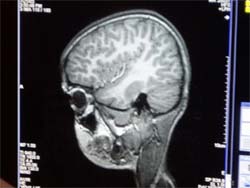
With the support of the National Basic Research Program, a research project entitled Key S&T Issues Concerning Molecular Imaging was officially launched on January 8 at the CAS Institute of Automation (IOA) in Beijing. Chaired by TIAN Jie, chief scientist of the project from IOA, the kick-off meeting was attended by more than 60 researchers from such universities and research institutions as Tsinghua University, Peking University, and the CAS Institute of Biophysics and IOA.
Focusing on the core theory on in vivo fluorescent labeling molecular imaging and related techniques, systems and deep-seated issues of radionuclide labeling molecular imaging, the project is to develop a research platform for the discipline in this country, and actively promote the domestic development and manufacturing of related diagnostic facilities in China, according to experts. The intellectual property rights for the key proprietary inventions and innovations attained by the project will provide valuable basis for Chinese researchers to participate in the global competition in a wider scope and deeper level.
The project is expected to offer new and effective means for exploring the pathology, clinic diagnostics, monitoring and efficacy evaluation in the treatment of cancers or other murderous diseases.
The research results are expected to dramatically speed up the developing tempo of new drugs and reducing the time for their pre-clinical research. They would also be used in in vivo quantitative assessment of a drug's toxic or side effects and efficacy, and exploration of drug-administering routes, stereo-structure, pharmacometrics, and impact of animal species on drug efficacy. In addition, they may promote the basic research of life sciences, opening a new era of in vivo, dynamic and continuous probe into gene's functions, cellular dynamics, and the whole process of life development. The enforcement of the project will greatly facilitate the realization of some key national targets in population and public health.
The project has the following objectives preset for its implementation: transport theory of light in complicated organisms with strong scattering property and related inverse algorithms; a unified computational framework and algorithmic platform for data analysis and treatment; a system for demonstration and appraisal of the in vivo molecular sectional imaging; and a system for fluorescence- or nuclide-labeling images. The work will explore the molecule's impact on the nuclide-tagging process applicable to clinical medicine and on the fluorescence-tagging process applicable to the models of small-sized animals.
The project's main research priorities include: In the imaging theory, the project will make an in-depth probe of the forward problems and reverse problems concerning in vivo fluorescent sectional imaging and make efforts on developing a prototype system for in vivo fluorescence sectional molecular imaging. In data analysis and treatment algorithms, studies will be conducted on the transport of photon in organisms and reverse algorithms, so as to develop a unified computational framework and algorithmic platform for data analysis and treatment of large-scale multi-mode molecular images. Through a multi-layered and multi-system comparison, a biological demonstration is to be carried out systematically on new theoretical methods, key techniques and prototype systems. In the aspect of molecular probes, studies will be conducted on the labeling technique for specific probes, the detection methods for their magnification and high-sensitivity. By taking advantage of the prototype system for in vivo molecular imaging, all real-time and dynamic processes of a cancer's pathology and development may be observed in an immediate and visual appraisal.





